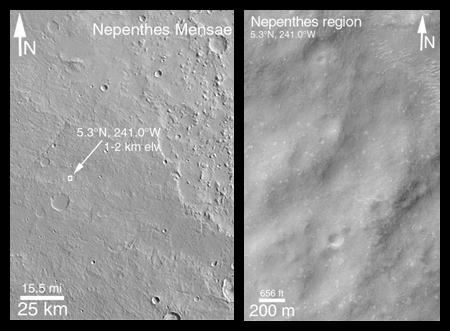
One of the original objectives of the Mars Orbiter Camera (MOC) when it was proposed to NASA in 1985 was to take pictures that would be used to assess future spacecraft landing sites. Images obtained by the Mars Global Surveyor (MGS) MOC since March 1999 provide the highest resolution views (1.5 to 4.5 meters (5-15 ft) per pixel) of the planet ever seen. Over the past several months, MOC science personnel have been examining these new data to develop a general view of what Mars is like at the meter-scale within the general latitude and elevation range that will be accessible to the Mars Surveyor 2001 lander. (i.e., about 5°N to 15°S latitude and lower than 2.5 km (1.6 mi) elevation).
Because MOC images only cover a tiny fraction of one percent of the surface of Mars, we have been seeking general correlations that exist between what is seen in a MOC high-resolution image and what can be seen in the lower-resolution Viking and Mariner 9 images taken in 1972 and 1976-1980.
The most important results thus far are illustrated in the four pictures above. Nearly 70% of the terrain examined follows two very simple, but unexpected "rules" -- (1) If the terrain appears rugged at the hundreds of meters to kilometers scale in a Viking or Mariner image, then it will appear smooth at the meter-scale in a MOC image. (2) If the terrain appears to be smooth in the Viking or Mariner image, it will be rough in the meter-scale MOC image.
The image pair above illustrates the first "rule." MOC2-137a (left) shows a rugged plain in the martian southern cratered highlands near the Nepenthes Mensae. The small white box indicates the location of the MOC image, which is on the right (MOC2-137b). The MOC image reveals that while the terrain is rough at the large scale, it is quite smooth at the meter-scale.
The Viking image shown here is illuminated from the upper right, while the MOC image is illuminated from the upper left. The MOC image was taken in April 1999, while the Viking image was obtained in the late 1970s. More details about this work are provided in an extended abstract (in Acrobat® PDF format) by M.C. Malin, K. S. Edgett, and T. J. Parker, "Characterization of terrain in the Mars Surveyor 2001 landing site latitude and elevation region using Mapping Phase Mars Global Surveyor MOC images," presented at the Second Mars Surveyor Landing Site Workshop, held June 22-23, 1999, in Buffalo, New York.
Malin Space Science Systems and the California Institute of Technology built the MOC using spare hardware from the Mars Observer mission. MSSS operates the camera from its facilities in San Diego, CA. The Jet Propulsion Laboratory's Mars Surveyor Operations Project operates the Mars Global Surveyor spacecraft with its industrial partner, Lockheed Martin Astronautics, from facilities in Pasadena, CA and Denver, CO.
